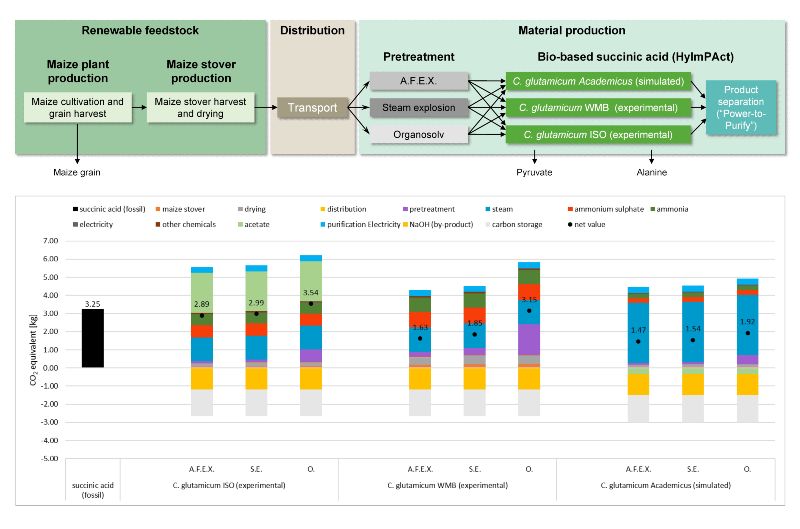Electrified downstream processes for organic acids
An alleged disadvantage of the selected organism Corynebacterium glutamicum for microbial organic acid production is that it must necessarily be carried out under neutral pH conditions. The subsequent down-stream processing traditionally involves several pH adjustments by addition of acids and bases. This results in a high auxiliary production of neutral salts with negative economic and ecological effects. However, this high salinity can be avoided completely by regulating the pH value electrochemically via water splitting. The underlying electrochemical “power-to-purity” process concept was developed by the partners at the RWTH Aachen University and adapted and optimized during “HyImPAct” for the separation of various organic acids (Fig. 1).
The downstream concept features two electrode reactions. First, the electrochemically induced crystallization in the vicinity of the anode (Eq. 1). Here the pH is decreased by H+ production, which enables crystallization of the targeted organic acid. Second, the electrochemical neutralization near the cathode, where the pH increases due to OH- production (Eq. 2).
Anode: 2 H2O -> O2 + 4 e- (1)
Cathode: 4 H2O + 4e- -> 2 H2 + 4 OH- (2)
These two reactions enable the in situ separation of the target organic acid and simultaneous buffering of the biotechnological production to its optimal pH. The pH neutral fermentation is followed by the crystallization of the organic acid in an anode reaction chamber. Thereafter, the crystals are separated from the solution and the remaining solution is transferred into a cathode reaction chamber, where the pH is adjusted to control the pH in the fermentation (Fig. 1).
Within HyImPAct we successfully demonstrated the feasibility of electrified downstream processing for the organic acid succinate and the aromatic acid protocatechuate.

Life Cycle Assessment of the production of bio-based succinic acid from maize stover
Using the Life Cycle Assessment (LCA) methodology we studied the environmental impact of bio-based succinic acid from maize stover produced in Germany. Despite missing data, limited process information and upscaling uncertainty, we have performed an ex-ante evaluation of three biotechnological processes. Specifically, process data from two lab-scale production processes for succinic acid using the C. glutamicum ISO and WMB strains were compared to the optimal production processes simulated in the former BOOST FUND project “BeProMod”). The outcome of this research consists of a set of potentials and limitations at an early development stage and allows to draw recommendations for process improvements.
The value chain has been divided in three sub-systems: production of second-generation biomass, distribution, and material production (Fig. 2). The material production sub-system includes the pretreatment of maize stover and the biotechnological processes to produce bio-based succinic acid (i.e. microbial bio-transformation and purification). We assume that all material production processes are located in the same industrial plant in Germany, which uses renewable electricity and the energy required to provide the steam is produced using natural gas.

The results show that all three biotechnological approaches - for almost all selected biomass pre-treatments - lead to a lower impact on the global warming potential (GWP) than the current industrial production of succinic acid based on fossil raw materials (CO2 equivalent of 3.25 kg). It should be noted that the biogenic carbon embodied in succinic acid (1.49 kg CO2 per kg succinic acid) was subtracted from the calculated GWP. Thus, carbon storage is presented as a negative value. This also applies to the formation of by-products insofar as these are further valuable materials with sensible subsequent uses. As expected, the simulated optimal production scenario for succinic acid performs best (CO2 equivalent of 1.47 kg) and thus serves as the basis for further optimization of the developed lab-scale bioprocesses.
Prof. Wolfgang Wiechert
Dr.-Ing. Stephan Noack
Prof. Dörthe Rother
Mohamed Labib
Christian Brüsseler
Laura Grabowski
Kevon Mack
Douglas Weber
Jochem Gätgens
IBG-1 Biotechnology
Forschungszentrum Jülich
Prof. Andreas Jupke
Moritz Doeker
Christian Kocks
Thomas Fuchs
AVT - Fluid Processing
RWTH Aachen University
Prof. Grit Walther
Dr. Angel Merchán
Michael Wolff
Operations Management
RWTH Aachen University
Prof. Michael Bott
Prof. Jan Marienhagen
IBG-1 Biotechnology
Forschungszentrum Jülich